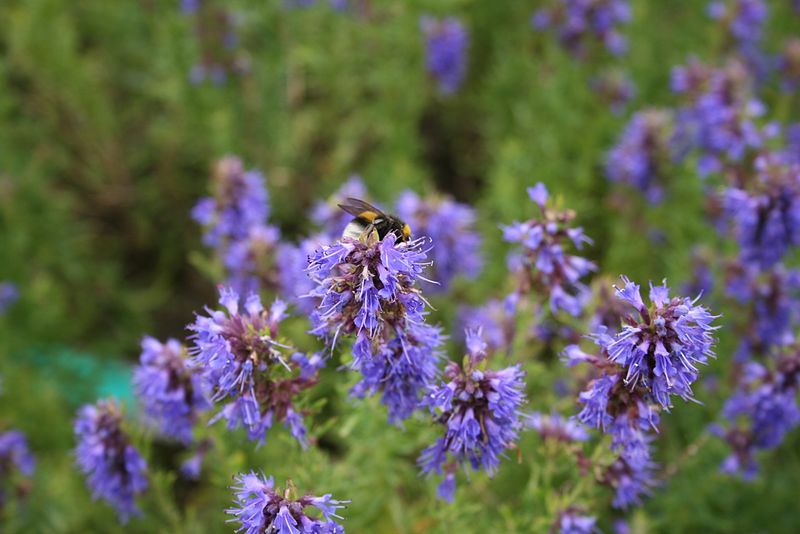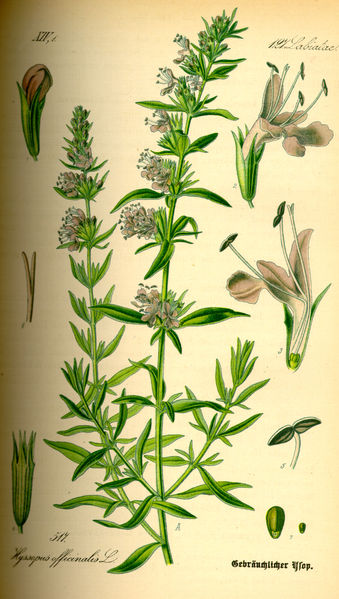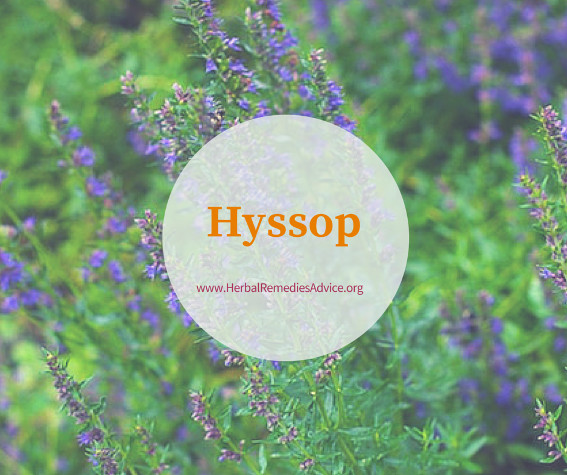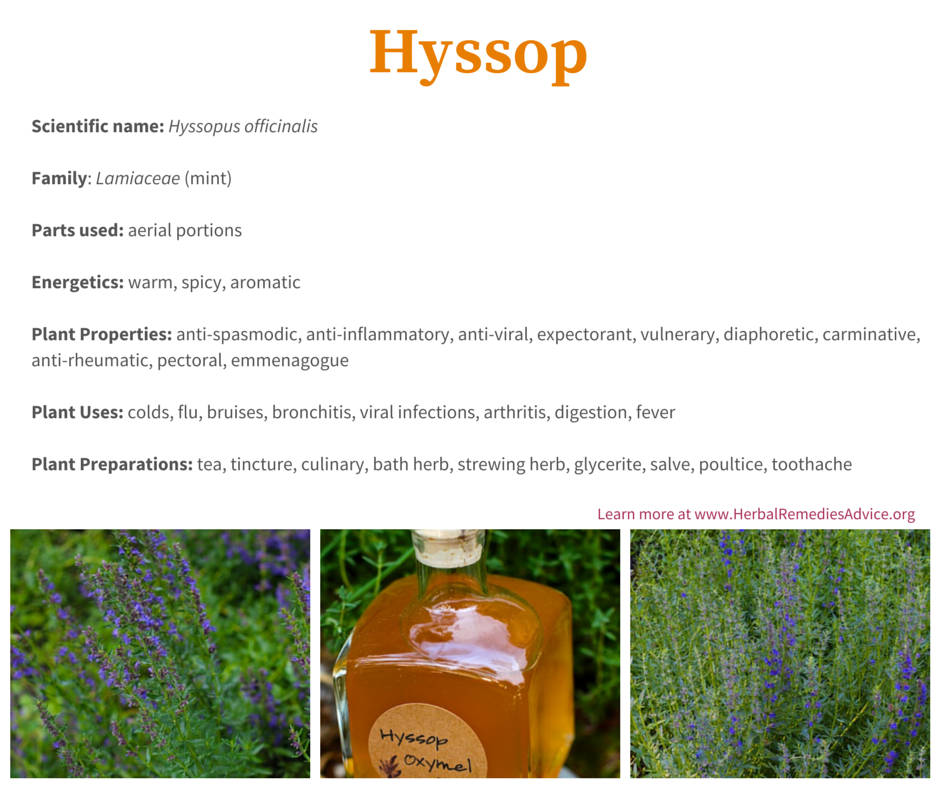Get weekly tips, recipes, and my Herbal Jumpstart e-course! Sign up for free today.

Hyssop Benefits
Share this! |
|
The Romans are said to have introduced hyssop wherever they settled, valuing it as both a ceremonial and healing plant.
- Herbalpedia
Hyssop
comes to us originally from the mediterranean and has been a beloved
medicinal plant for thousands of years. It now grows easily around the
world and has been naturalized throughout a lot of North America.
This easy-to-grow and abundant plant can be used for many common maladies and even as a food spice. Even bees love hyssop. Robert Dale Rogers says that “bees love the plant, and early apiarists rubbed their hives with the herb to encourage bees to stay put.”
Energetically, hyssop
can be explained as a warming and stimulating herb with a pungent
taste. We use it to warm up the body and get things moving! Think of it
for moving stagnation like stuck mucous, delayed menses or congealed
blood (bruises).
Here’s a closer look at how herbalists use this beautiful plant.
Hyssop Benefits for Colds, the Flu, Fevers, and Bronchitis
Hyssop
is probably most famously known as an herb for helping with symptoms of
a cold or flu. It is often used for children, but is very appropriate
for adults as well.
As
a stimulating diaphoretic it warms the body, pushing out coldness and
opening the pores. This is especially ideal for when a person feels cold
and is shivering with a slight fever.
For thousands of years hyssop has been used for coughs with congested mucus. It both stimulates mucus and expectorates mucus, which enables the lungs and coughing mechanisms to rid it from the body. Herbalist Nicholas Schnell recommends it for chronic sinus infections.
In
colds, accompanied with coughs and pectoral difficulty, where any
degree of fever is present, the somewhat old-fashioned combination of
hyssop with horehound has scarcely even yet been superseded by a more
serviceable remedy; the two agents are combined in equal proportions and, given in the form of infusion, as freely and copiously as the
patient can be prevailed upon to take it; the addition of honey to this
infusion is, in many cases, found to augment its power, and, a
consideration with patients possessing delicate stomachs, to some extent
to cover the taste of the medicine.
- Hatfield Botanic Pharmacopoeia, 1886
In
cough and cold prescriptions, particularly for whooping cough, and in
other troubles of infancy. The 1 ounce to 1 pint infusion is given in
wineglass doses, or according to age.
- Harold Ward, The Herbal Manual, 1936
Hyssop Benefits for Viral Infections
Hyssop has been shown to have antiviral properties and is being studied for applications against HIV and herpes.
Test-tube
studies show that hyssop stops the production of HIV without damaging
the infected cells. These results have encouraged some people living
with HIV to try the plant as an antiviral. Anecdotal reports suggest
that the plant is effective in treating HIV-related infections and
increasing CD4+ cell counts. - A Practice Guide to Herbal Therapies for People Living with HIV
Canadian Aids Treatment Information Exchange
Hyssop Benefits for Pain Relief, from Bruises to Arthritis
Hyssop is well known for its ability to lessen pain.
While arnica may be the modern-day favorite for bruises, Felter and Lloyd have high praise for hyssop’s abilities.
The leaves, applied to bruises, speedily relieve the pain, and disperse every spot or mark from the parts affected.
- King’s American Dispensatory, 1898
When used for arthritic pain, historical texts mention warm teas but also warm baths infused with hyssop. Older literature also mentions hyssop for toothaches.
Hyssop Benefits as an Emmenagogue
Emmenagogue
herbshelp to move symptoms of a stagnant pelvis, which can be delayed
menses, excessive menstrual cramping and scanty menses.
Because hyssop is an emmenagogue it should not be used in pregnancy.
 Photo Credit: Sten Porse
Photo Credit: Sten PorseHyssop Benefits in Promoting Digestion
Like many mint-family plants, hyssop
can be used to promote digestion, especially stagnant digestion in
which food feels stuck and heavy. It can be taken as a tea to promote
digestion, as part of a bitters blend or even used as a food spice.
Hyssop has a strong pungent taste with hints of camphor. It will give a distinctive taste to your culinary dishes. Start with very small amounts to avoid transforming a delicious dish into a “medicinal” dish.
When
it is eaten the liver becomes lively and it cleanses the lungs
somewhat. He who coughs and has a pain in the liver, or who suffers from
congestion in the lungs, or who suffers both conditions should eat
hyssop with meats or lard, and he will be better.
- Hildegard von Bingen
Hyssop has long been used to flavor liqueurs, from the infamous absinthe to the secretive recipe of Chartreuse.
[Hyssop
is] an essential but overlooked ingredient in absinthe (all the focus
is on the fennel, anise and wormwood, but any good absinthe has an
appreciable quantity of lemon balm and hyssop).
- jim mcdonald, herbalist
Hyssop Preparations
Hyssop
is ideally harvested just as it is going to flower when its essential
oils are at their highest. The aerial portions are harvested, cutting
just above the woody stems. They can then be dried for teas or prepared
in any of the following ways. Hyssop is commonly drank as a tea and can also be made into a syrup.
It can be prepared as a tincture or glycerite extraction. It was one of the herbs used to flavor the liqueur Chartreuse.
The fresh herb can be used sparingly in cooking. Check out the Herbalpedia entry for lots of different recipes using hyssop.
Maude Grieve says it was used as a bath herb for rheumatism, although a large quantity was needed.
Its aromatic qualities made it a popular strewing herb.
Click here to see my Hyssop Oxymel recipe.
Have a garden? Hyssop is easy to grow. You can buy hyssop seeds here.
Special Considerations
Hyssop is safe for most people to use. It should be avoided in pregnancy, and extremely large doses, especially of the essential oil, have been known to cause convulsions.
The Hyssop Plant
 Prof. Dr. Otto Wilhelm Thomé Flora von Deutschland, Österreich und der Schweiz 1885, Gera, Germany
Prof. Dr. Otto Wilhelm Thomé Flora von Deutschland, Österreich und der Schweiz 1885, Gera, GermanyHyssop is originally from the middle east and southern Europe but has spread to many places around the world as a garden herb. It is very easy to grow and is hardy to zone two.
It is a mint family plant and has a square stem with opposite leaves.
Flowers range from white (rare) to pink to blue to lavender. They have the characteristic mint family flower shape.
It grows as a fairly large bush or shrub and is a woody perennial.
Summary of Hyssop Benefits
Hyssop
has been loved for centuries for its ability to address many common
problems such as cold and flu symptoms and acute and chronic pain. This
herb warms the body and is used for a variety of ailments when things
are stuck: from congested mucus, to delayed menses, to bruises and
fevers.
You can easily find this herb in commerce or, if you have a garden, it can be easily grown into a beautiful bush.

Rosalee is an herbalist and author of the bestselling book Alchemy of Herbs: Transform Everyday Ingredients Into Foods & Remedies That Healand co-author of the bestselling book Wild Remedies: How to Forage Healing Foods and Craft Your Own Herbal Medicine. She's a registered herbalist with the American Herbalist Guild and has taught thousands of students through her online courses. Read about how Rosalee went from having a terminal illness to being a bestselling author in her full story here.

